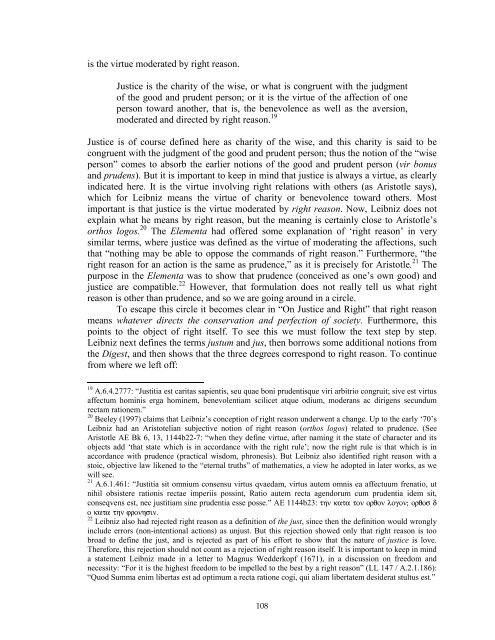Stony Brook University
Stony Brook University
Stony Brook University
Create successful ePaper yourself
Turn your PDF publications into a flip-book with our unique Google optimized e-Paper software.
is the virtue moderated by right reason.<br />
Justice is the charity of the wise, or what is congruent with the judgment<br />
of the good and prudent person; or it is the virtue of the affection of one<br />
person toward another, that is, the benevolence as well as the aversion,<br />
moderated and directed by right reason. 19<br />
Justice is of course defined here as charity of the wise, and this charity is said to be<br />
congruent with the judgment of the good and prudent person; thus the notion of the “wise<br />
person” comes to absorb the earlier notions of the good and prudent person (vir bonus<br />
and prudens). But it is important to keep in mind that justice is always a virtue, as clearly<br />
indicated here. It is the virtue involving right relations with others (as Aristotle says),<br />
which for Leibniz means the virtue of charity or benevolence toward others. Most<br />
important is that justice is the virtue moderated by right reason. Now, Leibniz does not<br />
explain what he means by right reason, but the meaning is certainly close to Aristotle’s<br />
orthos logos. 20 The Elementa had offered some explanation of ‘right reason’ in very<br />
similar terms, where justice was defined as the virtue of moderating the affections, such<br />
that “nothing may be able to oppose the commands of right reason.” Furthermore, “the<br />
right reason for an action is the same as prudence,” as it is precisely for Aristotle. 21 The<br />
purpose in the Elementa was to show that prudence (conceived as one’s own good) and<br />
justice are compatible. 22 However, that formulation does not really tell us what right<br />
reason is other than prudence, and so we are going around in a circle.<br />
To escape this circle it becomes clear in “On Justice and Right” that right reason<br />
means whatever directs the conservation and perfection of society. Furthermore, this<br />
points to the object of right itself. To see this we must follow the text step by step.<br />
Leibniz next defines the terms justum and jus, then borrows some additional notions from<br />
the Digest, and then shows that the three degrees correspond to right reason. To continue<br />
from where we left off:<br />
19 A.6.4.2777: “Justitia est caritas sapientis, seu quae boni prudentisque viri arbitrio congruit; sive est virtus<br />
affectum hominis erga hominem, benevolentiam scilicet atque odium, moderans ac dirigens secundum<br />
rectam rationem.”<br />
20 Beeley (1997) claims that Leibniz’s conception of right reason underwent a change. Up to the early ‘70’s<br />
Leibniz had an Aristotelian subjective notion of right reason (orthos logos) related to prudence. (See<br />
Aristotle AE Bk 6, 13, 1144b22-7: “when they define virtue, after naming it the state of character and its<br />
objects add ‘that state which is in accordance with the right rule’; now the right rule is that which is in<br />
accordance with prudence (practical wisdom, phronesis). But Leibniz also identified right reason with a<br />
stoic, objective law likened to the “eternal truths” of mathematics, a view he adopted in later works, as we<br />
will see.<br />
21 A.6.1.461: “Justitia sit omnium consensu virtus qvaedam, virtus autem omnis ea affectuum frenatio, ut<br />
nihil obsistere rationis rectae imperiis possint, Ratio autem recta agendorum cum prudentia idem sit,<br />
conseqvens est, nec justitiam sine prudentia esse posse.” AE 1144b23: thn kata ton orqon logon; orqos d<br />
o kata thn fronhsin.<br />
22 Leibniz also had rejected right reason as a definition of the just, since then the definition would wrongly<br />
include errors (non-intentional actions) as unjust. But this rejection showed only that right reason is too<br />
broad to define the just, and is rejected as part of his effort to show that the nature of justice is love.<br />
Therefore, this rejection should not count as a rejection of right reason itself. It is important to keep in mind<br />
a statement Leibniz made in a letter to Magnus Wedderkopf (1671), in a discussion on freedom and<br />
necessity: “For it is the highest freedom to be impelled to the best by a right reason” (LL 147 / A.2.1.186):<br />
“Quod Summa enim libertas est ad optimum a recta ratione cogi, qui aliam libertatem desiderat stultus est.”<br />
108
















